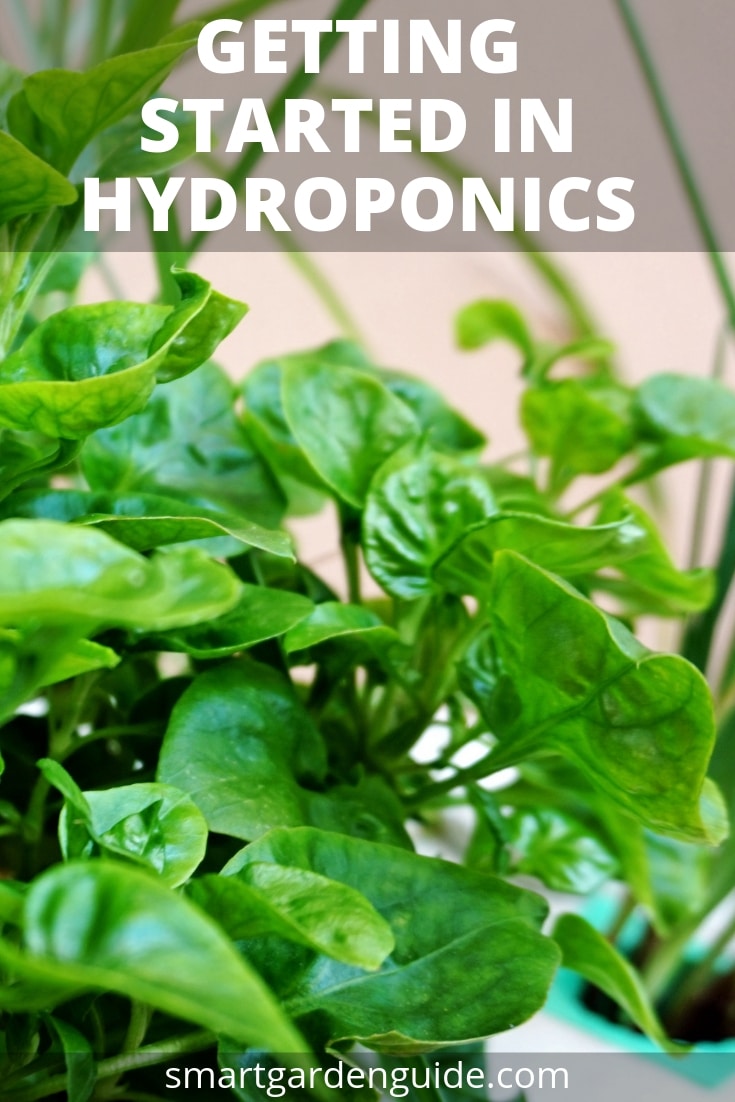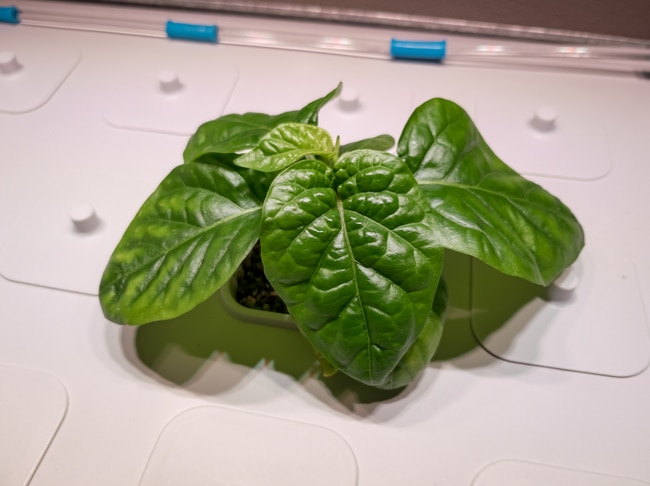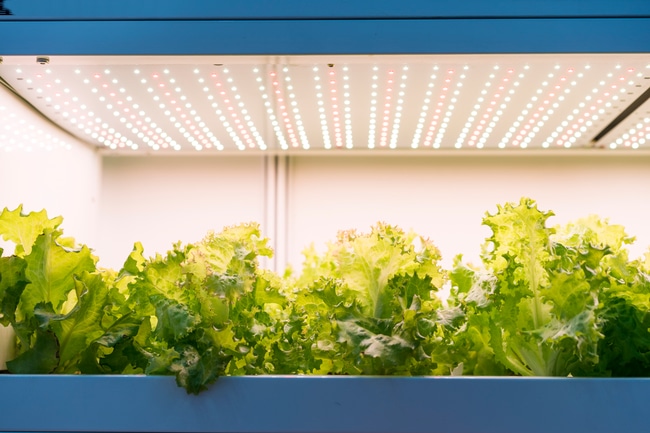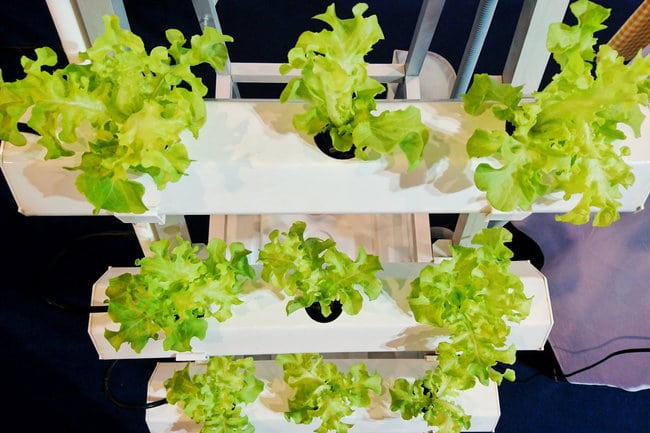Getting started in hydroponics can seem like a daunting task, when you begin to look at all the considerations that go into designing, building, and using a hydroponic growing system. But once you harvest your first gorgeous bounty, you’ll be ever so glad you did!
This beginner’s guide to hydroponics will walk you through the basic principles of hydroponics, answer many of your questions, and set you on your way to a fun and rewarding activity of which you’ll be reaping the benefits for years to come.
What Is Hydroponics?
The word “hydroponics” comes from the Greek words for “water” and “work.” It describes any method of growing terrestrial plants that uses water to deliver all the nutrients plants need directly to their roots, rather than having the roots dig around for these nutrients in a body of soil.
In hydroponics, nutrients are delivered to plant roots via a water-based nutrient solution. Most home hydroponics systems use a nutrient solution created by dissolving a commercial fertilizer blend in water. However, organic hydroponics systems use sources such as manure, bone meal, wood ash, and kelp.
In some types of hydroponics systems, the plants are grown in an inert medium. The purpose of this growing medium is to support the plants’ weight while helping to make the nutrient solution and oxygen available to the roots of the plants. There are many types of growing media, with the most popular being clay grow rocks, rockwool, coco coir, and perlite.
In systems that don’t require a growing medium, the plants are held in place at the base of the stem and the roots are exposed to nutrient solution in a growing container.

What Are The Benefits Of Hydroponics?
So, now that you know what hydroponics is, the question becomes, why would anyone choose to grow plants using technology-dependent methods that are so different from the way humans have cultivated plants for thousands of years?
Here are some of the benefits hydroponics offers over traditional cultivation of plants in soil:
- Eliminates the threat of pests and diseases commonly found in soil
- No need for harmful chemical insecticides and herbicides
- No weeding or tilling
- Fertilizer efficiencygreatly reduces runoff pollution of the environment
- Very efficient use of water
- Not limited to locations with good soil
- Efficient use of space
- Year-round growing
- Control over growing conditions
- Ideal growing conditions encourage plants to grow faster and healthier
- Easy harvesting
Which Hydroponics Systems Are Best For Beginners?
Now you’re ready to get started in hydroponics, but are wondering which systems are most suitable for beginners to build and maintain.
There are six types of hydroponics growing systems:
- Water culture
- Nutrient film technique
- Wick system
- Drip system
- Ebb and flow (flood and drain)
- Aeroponics
Click on any of the links for a more detailed article about each system.
If you’re looking for the simplest hydroponics system to set up, consider wick system hydroponics. This is a passive system, meaning it’s not dependent on mechanical parts. To build a hydroponic wick system, you’ll need a growing container, a reservoir, and a wick, all of which you can make out of regular household items. The only specialized hydroponics components you need are the nutrients, which all hydroponics systems require, and the growing medium, which could be materials such as perlite or coco coir that are easily available at gardening centers.
Water culture hydroponics is another good place for those getting started with hydroponics to begin. Rather than depending on a pump or wicking action to deliver solution to the plants, the roots are suspended in the solution in these systems. The simplest of these types of hydroponics is a passive system known as the Kratky method. Deep water culture hydroponics is almost as simple, but more productive, since it uses an aerator to ensure roots are getting an abundant supply of oxygen.
Drip system hydroponics is also a good choice for beginners because you can start out with a simple system and increase its sophistication later. While again, you can get creative when choosing construction materials as well as the configuration of your system, you’ll need a pump and some irrigation tubing. You’ll also need to monitor your drip system more closely than the other systems mentioned here, since it involves more components. For example, you’ll need to make sure your plants are getting enough moisture as they grow larger, and the drip emitters tend become clogged.
If you’re not the DIY type, you can find many excellent pre-built systems through hydroponics suppliers that provide you with everything you need to get started in hydroponics straight away. Price points will vary greatly depending on the size and sophistication of each system.
What Are The Best Plants To Grow When Getting Started In Hydroponics?
It’s possible to grow a large variety of plants hydroponically. But the plants that are the easiest to grow when you’re just getting started in hydroponics are non-fruiting plants that are durable, fast growing, and have shallow root systems. Salad greens and herbs of all kinds make great choices for hydroponics beginners.

What Do I Need To Know About The Water I Use For Hydroponics?
The quality of your water has a huge impact on the health of your plants, so you should have your water tested before using it for hydroponic growing. If you’re using city water, you can usually get a free report, while those using private well water need to have it tested – optimally, once a year.
The main indicator of water quality is the amount of total dissolved solids (TDS), measured in parts per million (ppm) or milligrams per liter. Water with more than 50 ppm of hardness is considered hard water, and it can throw your nutrient formulas out of balance, leading to plant deficiencies or toxicities.
While many people grow plants hydroponically with tap water, if you live in an area with particularly hard water, above 200 PPM, you may run into problems when growing your plants. If this is the case for you, one of the first things to do, is switch to filtered or distilled water.
While contaminants can be removed through filtration or distillation, reverse osmosis is the most efficient, reliable, and economical method.
Nutrient Solution Tips
For anyone getting started in hydroponics, the easiest way to ensure your plants are getting the nutrients they need is to purchase a commercial hydroponic fertilizer that’s formulated for the plants you want to grow and closely follow the instructions for use. Liquid nutrient solution will dissolve more easily, and two or three-part solutions are easiest for use throughout all plant growing phases.
You’ll need to monitor the nutrient solution in your reservoir and keep it topped up. As your plants grow, keep an eye on these nutrient solution factors:
Temperature
Optimal root zone temperatures vary depending on the plant. For lettuce, you should maintain your nutrient solution at 68-72 F (20-22 C).
pH Level
The pH of a solution measures its acidity, and it must be monitored closely to ensure that the plant roots are able to absorb the nutrients they need. For beginners, it’s best to test the pH of your solution daily, making sure to always test it just after adding nutrients. This is done using test strips, a liquid test kit, or a digital meter. Optimal pH levels vary, so you’ll need to refer to a chart. For lettuce, it’s 6.0-6.5.If the pH needs adjusting, apply chemicals made specifically for hydroponics, as they are the safest to use.
Electrical Conductivity (EC)
Because the nutrients used in hydroponics are made of mineral salts, the strength of the nutrient solution can be detected with an EC meter. For the vegetative growth stage, keep the EC around 1.2-1.6 for most plants. The EC tends to rise in a system due to evaporation and uptake of water by the plants; and if it becomes too high, the solution will become toxic to your plants. Therefore, you should measure the nutrient solution EC every few days and adjust it as necessary.
Most EC meters will convert EC readings to PPM counts, which can be useful at times. Here is a handy chart for reference.
How Much Space Do I Need For A Hydroponic System?
Once you’ve decided what you would like to grow, the next step is to determine how much space you’ll need for your plants.
Since hydroponics is known for being space efficient, people who are just getting started in hydroponics tend to overcrowd their plants, which reduces the amount of light that plants receive and encourages blight and mold. Remember, hydroponic plants grow larger than soil-grown plants. A general rule of thumb is to allow 18-30 square inches for plants that are less than 3 feet tall.
What Lighting Do I Need For Hydroponics?

With many hydroponic lighting options out there, your choice will depend on the size of your garden and the plants you are growing. Compact or T5 fluorescent grow lights are great for beginners, since they’re inexpensive, low heat, and well-suited for growing leafy greens. If you are a bit more serious, I would strongly recommend LED grow lights over any of the other options out there. LEDs are very efficient and reliable, and while they are still quite expensive to buy, the lifetime cost will be lower than most other forms of grow lighting.
To determine how much light energy you’ll need per square foot of gardening space, you simply need to know how much light intensity your plants require. Smaller leafy plants such as lettuce need about 20-30 watts per square foot, so lighting with a true output of 300 watts will cover 10-15 square feet of lettuce and similar crops.
To increase the efficiency of your lighting, consider installing reflectors. You can even help mitigate the heat generated by your lights if you use air-cooling reflectors.
What Conditions Do I Need To Monitor And Control In My Grow Room?
To achieve the best results with any hydroponics system, create a grow room that provides plants with the optimal conditions for fast, healthy growth. Here are the environmental factors that you need to monitor and control in your grow room:
Lighting
With indoor hydroponics, it’s very important that you strictly control the lighting. To achieve this, you can isolate your grow room using a commercial grow box. Or, you can locate your grow room in an interior space that has no windows and cover it with mylar to enhance the distribution of your lighting.
During the growing stage of your plants, you should generally provide 16-18 hours of light per day. If you want to induce flowering, reduce the hours to 12 per day, simulating the shorter days of late summer. Hydroponics suppliers offer different kinds of timers to automate these lighting cycles.
Air Movement
Ventilation is another crucial element for a successful hydroponics system. For growing areas that are small or naturally well ventilated, you may not need any supplemental ventilation. You could simply place a regular fan in the room to circulate air, and this will be sufficient for most hobby growers. However, for larger operations, a better option is to install an extractor fan to remove stale air, along with a ventilator to bring in fresh air from outside.
Plants use carbon dioxide in the air for photosynthesis, which gives them energy to grow, and more serious hydroponics growers often employ CO2 generators to accelerate growth. But good air circulation will ensure plenty of CO2 and also help regulate the heat and humidity of the space.
Temperature
It’s also important to monitor the temperature in your hydroponics grow room, where temperatures should be around 68 F (20 C) at night and about 74 F (23 C) during the daytime.
While any type of thermometer will do for monitoring temperatures, a thermometer that records the minimum and maximum temperatures reached during a given period will alert you to any harmful out-of-range temperatures that have occurred.
Room fans, extraction fans, and ventilators will help with cooling. Or, you could use air conditioning. On the other hand, if temperatures are too low in your grow room, introduce an electric heater.
Humidity
You should maintain a humidity level in your grow room of 40-60 percent to enhance plant growth and prevent mold from developing. Humidity is measured with a hygrometer. There are many monitors that will measure both temperature and humidity and they are very inexpensive to purchase.
Here again, an extraction fan will function well to remove excess humidity, or a dehumidifier, while a humidifier will increase moisture in the air if your grow room is too dry.
What Are The Challenges To Outdoor Hydroponics?
The most obvious advantage of setting up a hydroponics system outdoors as opposed to indoors is big cost savings on lighting and other climate control systems that suck up energy. However, outdoor hydroponics presents challenges of its own, since you don’t have any control of the growing environment.
Here are some of the issues to consider when designing an outdoor hydroponics system:
Lighting
To best take advantage of full-spectrum sunlight, choose a sheltered location with southern exposure.
Air Movement
Plants love a nice breeze, but too much wind causes stress. So be sure to locate your outdoor hydroponic garden with air movement in mind, and stake or trellis your plants in preparation for storms.
Temperature
To counteract the outdoor heat, take steps to make sure your nutrient solution remains cool. And top it off with cool water frequently, since plants will be transpiring much more than they would be indoors.
Nutrient Solution EC
When the temperature goes up, plants get thirstier. Lowering the nutrient solution EC a little helps them take up water more easily.
Pests
This is probably the biggest disadvantage to outdoors hydroponics. But since the best deterrence to sucking insects and other pests is healthy, nutrient-dense plants, hydroponics have an advantage over traditional gardening in dealing with unwanted creatures in the great outdoors.
If you’re ready to get started with hydroponics, check out some of my other articles, which are written with beginners in mind. I can’t recommend this hobby enough and would love to answer any questions you have about getting started. Leave a comment or use the contact form to get in touch.

